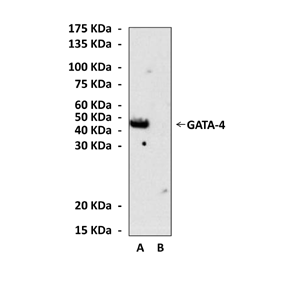Anti-GATA-4: Mouse GATA Binding Protein 4 Antibody |
 |
BACKGROUND The family of GATA transcription factors consists of six proteins (GATA-1–6). GATA-1–2–3 are important regulators of hematopoietic stem cells and their derivatives, whereas GATA-4, -5, and -6 genes are expressed in various mesoderm and endoderm-derived tissues. They have been found to play important roles in multiple stages of mammalian life, beginning with early development, continuing during organogenesis, and finally in homeostasis in the adult and involved in the development of many organ systems, including those for hematopoietic, cardiovascular, reproductive, and gut-endoderm derived tissues.1 A characteristic feature of GATA factors is a domain of two adjacent zinc fingers (Cys-X2-Cys-X17-Cys-X2-Cys) that directs preferential binding to the nucleotide sequence element 5′-(A/T)GATA(A/G)-3′ of target gene promoters.
Gene targeting and null mutation studies have revealed that GATA-4 plays a critical role in the regulation of embryogenesis as well as heart development. Mice with deletion of the GATA-4 locus exhibit embryonic lethality at E9.5 with a defect in fusion of two primordial tubes, whereas selective overexpression of GATA-4 in the heart results in cardiac hypertrophy.2 Recent studies also show that GATA-4 serves as a survival factor for cardiomyocytes, which protects the heart from doxorubicin-induced cardiotoxicity.3 The transcriptional function of GATA-4 is modulated via protein-protein interaction and/or posttranslational modifications. For instance, interaction of GATA-4 with another GATA family member, GATA-6, cooperatively activates ANF and BNP promoters, and phosphorylation on Ser-105 in GATA-4 by mitogen-activated protein kinase enhances its function of promoting cardiomyocyte differentiation as well as cardiomyocyte hypertrophy, suggesting that the posttranslational modification on GATA-4 is critical for its functional performance in the cellular physiological as well as pathological processes.4
REFERENCES
1. Pikkarainen, S. et al: Cardiovascul. Res. 63:196-207, 2004
2. Molkentin, J.D. & Olson, E.N.: Circulation 96:3833-5, 1997
3. Kim, Y et al: Mol. Pharmacol. 63:368–377, 2003
4. Kitta, K. et al: J. Biol. Chem. 278:4705-12, 2003
2. Molkentin, J.D. & Olson, E.N.: Circulation 96:3833-5, 1997
3. Kim, Y et al: Mol. Pharmacol. 63:368–377, 2003
4. Kitta, K. et al: J. Biol. Chem. 278:4705-12, 2003
Products are for research use only. They are not intended for human, animal, or diagnostic applications.
Параметры
Cat.No.: | CP10113 |
Antigen: | Purified recombinant human GATA-4 fragments expressed in E. coli. |
Isotype: | Mouse IgG |
Species & predicted species cross- reactivity ( ): | Human, Mouse |
Applications & Suggested starting dilutions:* | WB 1:1000 IP n/d IHC n/d ICC n/d FACS n/d |
Predicted Molecular Weight of protein: | 46 kDa |
Specificity/Sensitivity: | Detects endogenous GATA-4 proteins without cross-reactivity with other family members. |
Storage: | Store at -20°C, 4°C for frequent use. Avoid repeated freeze-thaw cycles. |
*Optimal working dilutions must be determined by end user.
Документы
Информация представлена исключительно в ознакомительных целях и ни при каких условиях не является публичной офертой








